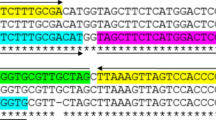Abstract
To date, no general method to detect wheat [Triticum aestivum vulgare (Vill.) Mackey] adulteration of spelt [T. aestivum spelta (L.) Thell.] exists. Exploiting a published allelic difference in γ-gliadin gene GAG56D, we developed and evaluated three PCR-based methods to determine the proportion of wheat in spelt flour and products. A sensitive wheat-specific PCR system was designed. Moreover, a heterologous internal standard was constructed for quantitative competitive (QC-)PCR. The standard was arbitrarily calibrated to 5% wheat DNA in spelt DNA. A PCR-RFLP system consisting of a GAG56D-specific PCR system with subsequent restriction was used to estimate the relative proportions of wheat and spelt in DNA mixtures. The three methods were successfully applied to seven commercial spelt samples and one self-produced bread. Five and three of the seven samples were found to contain more than 5% and 10% wheat, respectively. One sample appeared to contain no spelt at all. Analyzing the bread crumb with PCR-RFLP, we were able to estimate the wheat content of the flour which was used to produce the bread and thus demonstrated the applicability of PCR-RFLP to quantify processed products.
Similar content being viewed by others
Author information
Authors and Affiliations
Additional information
Received: 24 March 2000
Rights and permissions
About this article
Cite this article
von Büren, M., Stadler, M. & Lüthy, J. Detection of wheat adulteration of spelt flour and products by PCR. Eur Food Res Technol 212, 234–239 (2001). https://doi.org/10.1007/s002170000230
Issue Date:
DOI: https://doi.org/10.1007/s002170000230




